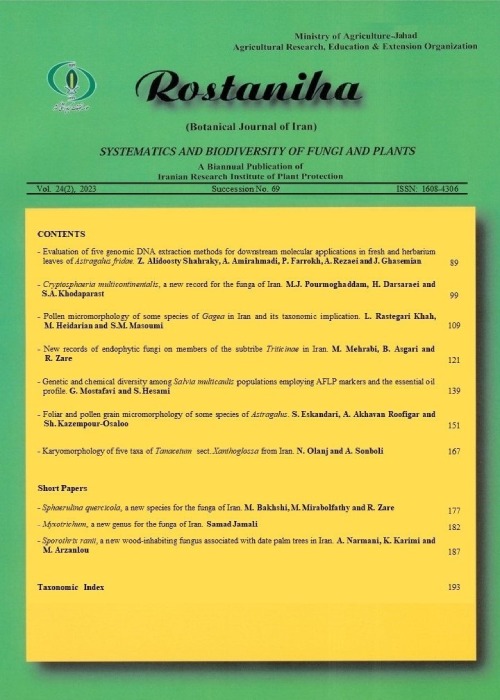Radulidium subulatum, new taxon for mycobiota of Iran
Alfalfa (Medicago sativa L.), a member of Fabaceae family, is a perennial or permanent plant with upright and very deep root that penetrates up to three meters into the soil, and therefore is the source of vitamins and minerals that takes from the soil. This plant is very important in terms of chemical and pharmaceutical compositions. In order to identify the fungi accompaning leaf spot symptoms of the alfalfa, leaves with leaf spot symptoms were collected from Sheikh Ali Khan region of the Chaharmahal and Bakhtiari province (Iran) during July 2018. The samples were transferred to laboratory and then small pieces (5 × 5 mm) were cut from the margin of leaf spots. Resulting leaf pieces were surface disinfested with 1% sodium hypochlorite for 30 sec. and then washed three times with sterilized water and were put on sterilized filter paper to remove excess water. Disinfested leaf pieces were transferred on 2% water agar medium. Isolates were purified by hyphal tip method and then were transferred to Petri dishes containing PDA culture medium and the grown fungal colonies were kept for seven days at 25 °C in continuous dark condition. Of the obtained fungal isolates, one isolate was identified as Radulidium subulatum (de Hoog) Arzanlou, W. Gams & Crous based on morphological features. According to the available literatures, this is the first report of Radulidium subulatum for mycobiota of Iran. The diameter of the fungus colony on malt extract agar (MEA) after 14 days of growth at 24 °C in continuous dark condition were 50 mm, and the colony of the fungus was pale gray in color (Fig. 1a). Conidiophores were pale brown, smooth, tapering toward the apex and have short conspicuous denticles at the tip, where the conidia were attached to the conidiophores. Denticles were densely crowded, prominent, blunt at the end and pale brown in color. The dimension of the conidiophores were 14–28(21) × 1.5–3(2.25) μm (Fig. 1 b–d). Conidia were solitary, single-celled, smooth, ellipsoid, pale brown and 4–7(5.5) × 1.5– 2(1.75) μm in diameter. Conidia had short hilum with about one micrometer in length (Fig. 1 e, f). Specimen examined: Iran: Chaharmahal and Bakhtiari province, Sheikh Ali Khan farms, on Medicago sativa L., 11.07.2018, Samira Karimzadeh, isolate ShnY2-1 (isolate in the Agricultural Microbial Culture Collection of Agricultural Biotechnology Research Institute of Iran, Karaj ABRIICC 10176). According to the literature review, the morphological features of the investigated isolate were the same with description of R. subulatum provided by Arzanlou et al. (2007). In addition to the investigated isolate, isolates of Phoma and Aspergillus were also recovered from the same leaf spot symptoms of the alfalfa plants.
- حق عضویت دریافتی صرف حمایت از نشریات عضو و نگهداری، تکمیل و توسعه مگیران میشود.
- پرداخت حق اشتراک و دانلود مقالات اجازه بازنشر آن در سایر رسانههای چاپی و دیجیتال را به کاربر نمیدهد.


